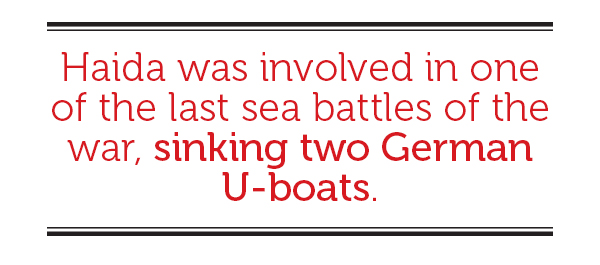
In the course of its remarkable life, HMCS Haida was attacked by German bombers, engaged with enemy battleships, participated in the Normandy invasion, escorted Russian convoys, sank U-boats, circumnavigated the globe, and shelled trains during the Korean War. One of 27 Tribal-class destroyers built between 1937 and 1945, Haida is the only one that has survived. It sank more enemy ships than any other Canadian warship, earning it the nickname “the fightingest ship in the Royal Canadian Navy.”
Haida was launched in a shipyard in Newcastle upon Tyne, North East England, on Aug. 25, 1942, and commissioned into RCN service a year later. Its first few months were spent in escort duty, but it saw more action the following year.
In January 1944, Haida joined Operation Tunnel and Operation Hostile along the French coast of the English Channel, participating in 19 missions. Next up was Operation Overlord and the invasion of Normandy. In early June, it engaged Germany’s 8th Destroyer Flotilla and sank one destroyer. A few weeks later, it sank a German U-boat in the English Channel.
In August, it was part of a force that attacked a German convoy, sinking two minesweepers, a patrol boat and a coastal launch. During that battle, two of Haida’s crew were killed and another eight injured when a shell exploded in one of Haida’s turrets.

By the spring of 1945, it was off the Norwegian coast laying mines, and a few months later was involved in one of the last sea battles of the war, sinking two German U-boats.
In November 1949, it was back in Halifax and pressed into service to rescue 18 crew members of a U.S. Air Force bomber that crashed in the Atlantic. Within a month, it was downgraded to a depot and accommodation ship.
With the start of the Korean War in June 1950, Haida was converted into a destroyer escort, patrolling off the Korean coast. It escorted aircraft carriers and performed coastal bombardments, joining the “trainbusters club” after it hit a Korean train north of Riwon.
After the Korean War, Haida was reassigned to NATO Cold War anti-submarine duty in the North Atlantic and the West Indies. But by 1958, it was showing its age. The hull was cracked, its equipment failing, the steering going. It was becoming clear that Haida would need to be scrapped. In 1963, as befitting a war hero, it did a farewell tour of the Great Lakes before it was sent to the scrapyard.
One of the people on board for that tour was Neil Bruce, who had served in the RCN. He and others formed a company—HAIDA Inc.—with the aim of acquiring Haida and preserving it. They bought it for $20,000 in 1964. It was eventually towed to Toronto, restored, purchased by the Ontario government for one dollar, and served as a training facility and tourist attraction.
In 1984, Haida was designated a National Historic Site of Canada. It is now berthed in Hamilton. A year ago, it was designated the ceremonial flagship of the RCN, a fitting honour for so storied a ship.
Advertisement












